Reconstruction of the Cretaceous Palaeogeographic Position of Hainan Island and Its Tectonic Significance
Abstract
1. Introduction

2. Geological Setting
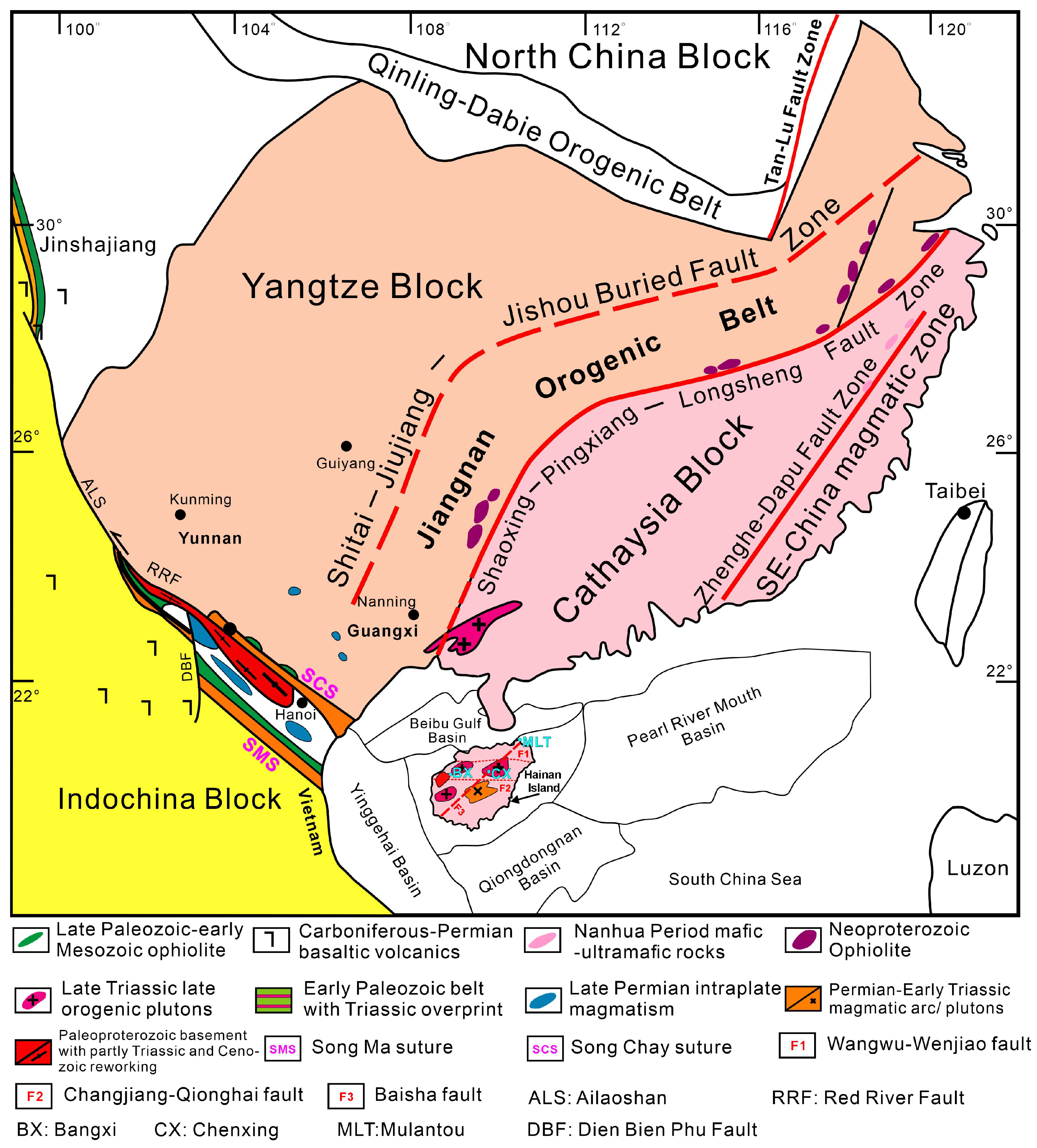
3. Methodology and Data Sources
4. Results
5. Discussion
5.1. Breakup of Hainan Island from South China
5.2. Collage of Hainan Island to South China
6. Conclusions
Author Contributions
Funding
Data Availability Statement
Conflicts of Interest
References
- Metcalfe, I. Gondwanaland dispersion, Asian accretion and evolution of eastern Tethys. Aust. J. Earth Sci. 1996, 43, 605–623. [Google Scholar] [CrossRef]
- Metcalfe, I. Multiple Tethyan ocean basins and orogenic belts in Asia. Gondwana Res. 2021, 100, 87–130. [Google Scholar] [CrossRef]
- Ren, H.; Hu, J.; Li, S.; Zhou, D.; Somerville, I.; Wang, L.; Liu, Y.; Suo, Y.; Yu, S.; Wang, X. Early Palaeozoic affinity of Hainan Island to Gondwana: New clues from metamorphic monazite and titanite of the Baoban Complex. Lithos 2024, 482, 107708. [Google Scholar] [CrossRef]
- Metcalfe, I.; Shergold, I.H.; Li, Z.X. Gondwana dispersion and Asian accretion: Field work on Hainan Island. Episodes 1993, 16, 443–447. [Google Scholar]
- Li, Z.X.; Metcalfe, I.; Wang, X. Vertical-axis block rotations in southwestern China since the Cretaceous: New Paleomagnetic results from Hainan Island. Geophys. Res. Lett. 1995, 22, 3071–3074. [Google Scholar] [CrossRef]
- Zhou, D.; Ru, K.; Chen, H. Kinematics of Cenozoic extension on the South China Sea continental margin and its implications for the tectonic evolution of the region. Tectonophysics 1995, 251, 161–177. [Google Scholar] [CrossRef]
- Zhou, D.; Sun, Z.; Chen, H.; Xu, H.; Wang, W.; Pang, X.; Cai, D.; Hu, D. Mesozoic paleogeography and tectonic evolution of South China Sea and adjacent areas in the context of Tethyan and Paleo-Pacific interconnections. Isl. Arc 2008, 17, 186–207. [Google Scholar] [CrossRef]
- Clift, P.; Lin, J. Preferential mantle lithospheric extension under the South China margin. Mar. Pet. Geol. 2001, 18, 929–945. [Google Scholar] [CrossRef]
- Hall, R. Cenozoic geological and plate tectonic evolution of SE Asia and the SW Pacific: Computer-based reconstructions, model and animations. J. Asian Earth Sci. 2002, 20, 353–431. [Google Scholar] [CrossRef]
- Li, X.; Zhou, H.; Chung, S.; Ding, S.; Liu, Y.; Lee, C.; Ge, W.; Zhang, Y.; Zhang, R. Geochemical and Sm-Nd isotopic characteristics of metabasites from central Hainan Island, South China and their tectonic significance. Isl. Arc 2002, 11, 193–205. [Google Scholar] [CrossRef]
- Liu, X.; Chen, Y.; Wang, W.; Xia, M.; Hu, J.; Li, Y.; Hu, D.; Song, B. Carboniferous eclogite and garnet–omphacite granulite from northeastern Hainan Island, South China: Implications for the evolution of the eastern Palaeo-Tethys. J. Metamorph. Geol. 2021, 39, 101–132. [Google Scholar] [CrossRef]
- Jia, L.; Wei, Y.; Zhang, L.; Xu, G.; Liang, D.; Wang, C.; Yang, X.; Ma, X.; Sun, D.; Hu, D. Holocene evolution of the Qiongzhou Strait between Hainan Island and mainland China: Evidence from geological drilling. Palaeogeogr. Palaeoclimatol. Palaeoecol. 2025, 675, 113064. [Google Scholar] [CrossRef]
- Zhao, G.; Cawood, P.A.; Li, S.; Wilde, S.A.; Sun, M.; Zhang, J.; He, Y.; Yin, C. Amalgamation of the North China Craton: Key issues and discussion. Precambrian Res. 2012, 222, 55–76. [Google Scholar] [CrossRef]
- Faure, M.; Lepvrier, C.; Nguyen, V.V.; Vu, T.V.; Lin, W.; Chen, Z.C. South China block-Indochina collision: Where, when, and how? J. Asian Earth Sci. 2014, 79, 260–274. [Google Scholar] [CrossRef]
- Li, Q.; Lin, W.; Wang, Y.; Faure, M.; Meng, L.; Wang, H.; Nguyen, V.V.; Luong Thi Thu, H.; Lepvrier, C.; Chu, Y. Detrital zircon U-Pb age distributions and Hf isotopic constraints of the Ailaoshan-Song Ma Suture Zone and their Palaeogeographic implications for the Eastern Paleo-Tethys evolution. Earth Sci. Rev. 2021, 221, 103789. [Google Scholar] [CrossRef]
- Zhou, Y.; Sun, S.; Feng, Z.; Xu, C.; Cai, Y.; Liang, X.; Liu, X.; Du, Y. A new insight into the eastern extension of the Proto-Tethyan margin of Gondwana by Early Paleozoic volcanic rocks in South China. Lithos 2021, 398, 106328. [Google Scholar] [CrossRef]
- Zhang, H.; Xu, Y.; Cawood, P.A.; Zi, J.; Zhou, J.; Du, Y. Linking the Paleozoic evolution of Hainan Island to Indochina and Australia: Implication for the palaeogeography of the Eastern Tethys Ocean. Tectonophysics 2023, 858, 229882. [Google Scholar] [CrossRef]
- Yang, S.; Yu, Z.; Guo, L.; Shi, Y. The division and palaeomagnetism of Hainan Island and plate tectonic significance. J. Nanjing Univ. 1989, 1, 38–46. (In Chinese) [Google Scholar]
- Hsü, K.J.; Li, J.; Chen, H.; Wang, Q.; Sun, S.; Şengör, A.M.C. Tectonics of South China: Key to understanding West Pacific geology. Tectonophysics 1990, 183, 9–39. [Google Scholar] [CrossRef]
- Xian, H.; Zhang, S.; Li, H.; Xiao, Q.; Chang, L.; Yang, T.; Wu, H. How Did South China Connect to and Separate from Gondwana? New Paleomagnetic Constraints from the Middle Devonian Red Beds in South China. Geophys. Res. Lett. 2019, 46, 7371–7378. [Google Scholar] [CrossRef]
- Replumaz, A.; Tapponnier, P. Reconstruction of the deformed collision zone between India and Asia by backward motion of lithospheric blocks. J. Geophys. Res. Solid Earth 2003, 108, 2285. [Google Scholar] [CrossRef]
- Liang, G.H. Eight evidences on Hainan Island separating from China’s Beibuwan Gulf with rotation. Acta Geol. Sin. 2013, 87 (Suppl. S1), 73–76. [Google Scholar]
- Liang, G.H. A study of the genesis of Hainan Island. Geol. China 2018, 45, 693–705. [Google Scholar]
- Cai, J.X.; Zhang, K.J. A new model for the Indochina and South China collision during the Late Permian to the Middle Triassic. Tectonophysics 2009, 467, 35–43. [Google Scholar] [CrossRef]
- Faure, M.; Lin, W.; Chu, Y.; Lepvrier, C. Triassic tectonics of the southern margin of South China Block. Comptes Rendus Geosci. 2016, 348, 5–14. [Google Scholar] [CrossRef]
- Yu, J.; Mao, J.; Chen, F.; Wang, Y.; Che, L.; Wang, T.; Liang, J. Metallogeny of the Shilu Fe–Co–Cu deposit, Hainan Island, South China: Constraints from fluid inclusions and stable isotopes. Ore Geol. Rev. 2014, 57, 351–362. [Google Scholar] [CrossRef]
- Lepvrier, C.; Faure, M.; Van, V.N.; Vu, T.V.; Lin, W.; Ta, T.T.; Ta, P.H. North-directed Triassic nappes in northeastern Vietnam (east Bac Bo). J. Asian Earth Sci. 2011, 41, 56–68. [Google Scholar] [CrossRef]
- Wang, S.; Mo, Y.; Wang, C.; Ye, P. Paleotethyan evolution of the Indochina Block as deduced from granites in northern Laos. Gondwana Res. 2016, 38, 183–196. [Google Scholar] [CrossRef]
- Zhu, R.; Zhao, P.; Zhao, L. Tectonic evolution and geodynamics of the Neo-Tethys Ocean. Sci. China Earth Sci. 2022, 65, 1–24. [Google Scholar] [CrossRef]
- Cai, Y.F.; Wang, Y.J.; Cawood, P.A.; Zhang, Y.Z.; Zhang, A.M. Neoproterozoic crustal growth of the Southern Yangtze Block: Geochemical and zircon U-Pb geochronological and Lu–Hf isotopic evidence of Neoproterozoic diorite from the Ailaoshan zone. Precambrian Res. 2015, 266, 137–149. [Google Scholar] [CrossRef]
- Cai, Y.F.; Liu, H.C.; Feng, Z.H.; Zhou, Y.; Liu, X.J.; Wang, Z.L.; Ma, L.Y.; Li, Z.L.; Xu, J.F. Neoproterozoic active margin of the SW South China Block: Constraints from U-Pb ages, Sr-Nd isotopes and geochemical data for the gabbro and granodiorite along the Ailaoshan tectonic belt. Lithos 2020, 358–359, 105387. [Google Scholar] [CrossRef]
- Wu, X.; Hu, J.; Chen, L.; Liu, L.; Liu, L. Paleogene India-Eurasia collision constrained by observed plate rotation. Nat. Commun. 2023, 14, 7272. [Google Scholar] [CrossRef]
- Tapponnier, P.; Peltzer, G.; Le Dain, A.Y.; Armijo, R.; Cobbold, P. Propagating extrusion tectonics in Asia: New insights from simple experiments with plasticine. Geology 1982, 10, 611–616. [Google Scholar] [CrossRef]
- Tapponnier, P.; Lacassin, R.; Leloup, P.H.; Schärer, U.; Zhong, D.; Wu, H.; Liu, X.; Ji, S.; Zhang, L.; Zhong, J. The Ailao Shan/Red River metamorphic belt: Tertiary left-lateral shear between Indochina and South China. Nature 1990, 343, 431–437. [Google Scholar] [CrossRef]
- Li, L.; Lu, S.; Gao, R.; Lei, C. Seismic reflection imaging of a deep-penetrating Red River fault in the Yinggehai basin, northwest of the South China Sea. Geophys. Res. Lett. 2023, 50, e2023GL104598. [Google Scholar] [CrossRef]
- Wang, Y.; Lin, W.; Faure, M.; Lepvrier, C.; Chu, Y.; Nguyen, V.V.; Thu, H.L.T.; Wei, W.; Liu, F.; Vu, T.V. Detrital Zircon U-Pb Age Distribution and Hf Isotopic Constraints from the Terrigenous Sediments of the Song Chay Suture Zone (NE Vietnam) and Their Palaeogeographic Implications on the Eastern Paleo-Tethys Evolution. Tectonics 2021, 40, e2020TC006611. [Google Scholar] [CrossRef]
- Wang, Y.; Lin, W.; Faure, M.; Nguyen, V.V.; Meng, L.; Chu, Y.; Wei, W.; Thu, H.L.T.; Lepvrier, C.; Vu, T.V.; et al. Correlation among the Ailaoshan–Song Ma–Song Chay orogenic belts and implications for the evolution of the eastern Paleo-Tethys Ocean. Tectonophysics 2022, 843, 229618. [Google Scholar] [CrossRef]
- Lin, W.; Liu, F.; Wang, Y.; Meng, L.; Faure, M.; Chu, Y.; Van Nguyen, V.; Wu, Q.; Wei, W.; Thu, H.L.T.; et al. Temporal and spatial heterogeneity of the Ailaoshan–Song Ma–Song Chay ophiolitic mélange, and its significance on the evolution of Paleo-Tethys. Comptes Rendus Geosci. 2024, 356, 115–136. [Google Scholar] [CrossRef]
- Yang, L.; Ren, J.; McIntosh, K.; Meng, L.; Faure, M.; Chu, Y.; Nguyen, V.V.; Wu, Q.; Wei, W.; Thu, H.L.T.; et al. The structure and evolution of deepwater basins in the distal margin of the northern South China Sea and their implications for the formation of the continental margin. Mar. Pet. Geol. 2018, 92, 234–254. [Google Scholar] [CrossRef]
- Liu, Y.; Wu, Z.; Liu, L.; Yan, S.; Hu, L.; Ping, M.; Zhang, M. Cenozoic structure and tectonics of north subbasins in Beibu Gulf basin, northern South China Sea. Tectonophysics 2021, 812, 228912. [Google Scholar] [CrossRef]
- Wu, T.; Pei, J.; Fu, Y.; Deng, D.; Chen, G.; Xu, T.; Wang, D.; Zhou, Z.; Wang, W. The Red River Fault zone and its deep structural characteristics revealed by high-resolution seismic data in the Yinggehai Basin, South China Sea. J. Struct. Geol. 2025, 198, 105457. [Google Scholar] [CrossRef]
- Zhao, J.; Liu, C.; Zhao, J.; Xu, Q. Reconstruction of the Cenozoic Deformation of the Yinggehai Basin and Beibu Gulf Basin, South China Sea. J. Mar. Sci. Eng. 2025, 13, 322. [Google Scholar] [CrossRef]
- Hu, Y.; Hao, M.; Ji, L.; Song, S. Three-dimensional crustal movement and the activities of earthquakes, volcanoes and faults in Hainan Island, China. Geodesy Geodyn. 2016, 7, 284–294. [Google Scholar] [CrossRef]
- Liu, X.; Hu, J.; Chen, L.; Xia, M.; Han, J.; Hu, D. The Mulantou metamorphic complex from northeastern Hainan Island, South China: Compositions, ages and tectonic implications. Acta Geol. Sin. 2022, 96, 3051–3083. [Google Scholar]
- Zhou, Y.; Yan, Y.; Liu, H.; Cai, J.; Zhou, M.; Zhang, X.; Wang, Y.; Shen, B. U-Pb isotope geochronology of syntectonic granites from Hainan Island, South China: Constraints on tectonic evolution of the eastern Paleo-Tethys ocean. J. Ocean Univ. China 2020, 19, 1315–1330. [Google Scholar] [CrossRef]
- Xu, Z.J.; Gao, S.Y.; Kong, J.T.; Cheng, R. Response of Permian sediment provenance conversion in Hainan Island to the closure of the Eastern Paleo-Tethys Ocean. Aust. J. Earth Sci. 2024, 71, 847–862. [Google Scholar] [CrossRef]
- Li, X.; Li, Z.; Li, W.; Wang, Y. Initiation of the Indosinian orogeny in South China: Evidence for a Permian magmatic arc on Hainan Island. J. Geol. 2006, 114, 341–353. [Google Scholar] [CrossRef]
- Yan, Q.; Metcalfe, I.; Shi, X. U-Pb isotope geochronology and geochemistry of granites from Hainan Island (northern South China Sea margin): Constraints on late Paleozoic-Mesozoic tectonic evolution. Gondwana Res. 2017, 49, 333–349. [Google Scholar] [CrossRef]
- He, H.; Wang, Y.; Cawood, P.A.; Qian, X.; Zhang, Y.; Zhao, G. Permo–Triassic granitoids, Hainan Island, link to Paleotethyan not Paleopacific tectonics. Bull. Geol. Soc. Am. 2020, 132, 2067–2083. [Google Scholar] [CrossRef]
- Yin, Z.; Lu, X.; Huang, Q.; Zheng, H.; Cai, Z.; Hua, Y.; Zhang, C.; Deng, F.; Xie, A. Petrogenesis and tectonic implications of late Permian and Triassic granitoids on Hainan Island, South China. Geol. J. 2022, 57, 1837–1849. [Google Scholar] [CrossRef]
- Liu, J.Q.; Ren, Z.Y.; Nichols, A.R.L.; Song, M.S.; Qian, S.P.; Zhang, Y.; Zhao, P.P. Petrogenesis of Late Cenozoic basalts from North Hainan Island: Constraints from melt inclusions and their host olivines. Geochim. Cosmochim. Acta 2015, 152, 89–121. [Google Scholar] [CrossRef]
- Wang, X.C.; Li, Z.X.; Li, X.H.; Li, J.; Liu, Y.; Long, W.; Zhou, J.; Wang, F. Temperature, pressure, and composition of the mantle source region of Late Cenozoic basalts in Hainan Island, SE Asia: A consequence of a young thermal mantle plume close to subduction zones? J. Petrol. 2012, 53, 177–233. [Google Scholar] [CrossRef]
- Zhao, D.; Toyokuni, G.; Kurata, K. Deep mantle structure and origin of Cenozoic intraplate volcanoes in Indochina, Hainan and South China Sea. Geophys. J. Int. 2021, 225, 572–588. [Google Scholar] [CrossRef]
- Xia, B.D.; Yu, J.H.; Fang, Z.; Wang, C.Y.; Shi, G.Y. The Carboniferous bimodal volcanic rocks in Hainan Island and their plate tectonic setting. Acta Petrol. Sin. 1991, 7, 54–62. [Google Scholar] [CrossRef]
- Tang, H. Geochemical characteristics of the basalt from Chenxing, Hainan Island, and their tectonic implication. Geotecton. Metallogenia 1999, 23, 323–327. [Google Scholar]
- Li, X.; Zhou, H.; Ding, S.; Lee, C.; Zhang, R.; Zhang, Y.; Ge, W. Sm-Nd isotopic constraints on the age of the Bangxi-chenxing ophiolite in Hainan Island: Implications for the tectonic evolution of eastern Paleo-Tethys. Acta Petrol. Sin. 2000, 16, 425–432. [Google Scholar]
- Fu, L.L.; Shen, Z.Y.; He, L.; Chen, X.G.; Tan, L.M.; Yang, S.F. Cretaceous paleomagnetic results from Hainan Island and its tectonic implications. Acta Geol. Sin. 2010, 84, 183–194. (In Chinese) [Google Scholar]
- Liu, Y.Y.; Morinaga, H. Cretaceous palaeomagnetic results from Hainan Island in south China supporting the extrusion model of Southeast Asia. Tectonophysics 1999, 301, 133–144. [Google Scholar] [CrossRef]
- Shu, L.; Yao, J.; Wang, B.; Faure, M.; Charvet, J.; Chen, Y. Neoproterozoic plate tectonic process and Phanerozoic geodynamic evolution of the South China Block. Earth Sci. Rev. 2021, 216, 103596. [Google Scholar] [CrossRef]
- Whittaker, A.C. How do landscapes record tectonics and climate? Lithosphere 2012, 4, 160–164. [Google Scholar] [CrossRef]
- Allen, P.A. From landscapes into geological history. Nature 2008, 451, 274–276. [Google Scholar] [CrossRef]
- Whipple, K.X. The influence of climate on the tectonic evolution of mountain belts. Nat. Geosci. 2009, 2, 97–104. [Google Scholar] [CrossRef]
- Armitage, J.J.; Duller, R.A.; Whittaker, A.C.; Allen, P.A. Transformation of tectonic and climatic signals from source to sedimentary archive. Nat. Geosci. 2011, 4, 231–235. [Google Scholar] [CrossRef]
- Bahadori, A.; Holt, W.E.; Feng, R.; Austermann, J.; Loughney, K.M.; Salles, T.; Moresi, L.; Beucher, R.; Lu, N.; Flesch, L.M. Coupled influence of tectonics, climate, and surface processes on landscape evolution in southwestern North America. Nat. Commun. 2022, 13, 4437. [Google Scholar] [CrossRef] [PubMed]
- Shen, Z.K.; Lü, J.; Wang, M.; Bürgmann, R. Contemporary crustal deformation around the southeast borderland of the Tibetan Plateau. J. Geophys. Res. Solid Earth 2005, 110, B11409. [Google Scholar] [CrossRef]
- Ellis, M.A.; Barnes, J.B. A global perspective on the topographic response to fault growth. Geosphere 2015, 11, 1008–1023. [Google Scholar] [CrossRef]
- Ebinger, C.J.; Keir, D.; Bastow, I.D.; Whaler, K.; Hammond, J.O.S.; Ayele, A.; Miller, M.S.; Tiberi, C.; Hautot, S. Crustal structure of active deformation zones in Africa: Implications for global crustal processes. Tectonics 2017, 36, 3298–3332. [Google Scholar] [CrossRef]
- Morley, C.K.; Wang, Y. The Cenozoic hyper-oblique collision zone of Indochina: A re-appraisal of escape tectonics. Earth Sci. Rev. 2023, 243, 104453. [Google Scholar] [CrossRef]
- Smith, W.H.F.; Sandwell, D.T. Global sea floor topography from satellite altimetry and ship depth soundings. Science 1997, 277, 1956–1962. [Google Scholar] [CrossRef]
- Sandwell, D.T.; Müller, R.D.; Smith, W.H.F.; Garcia, E.; Francis, R. New global marine gravity model from CryoSat-2 and Jason-1 reveals buried tectonic structure. Science 2014, 346, 65–67. [Google Scholar] [CrossRef]
- Lesur, V.; Hamoudi, M.; Choi, Y.; Dyment, J.; Thébault, E. Building the second version of the world digital magnetic anomaly map (WDMAM). Earth Planets Space 2016, 68, 27. [Google Scholar] [CrossRef]
- Ren, J.; Niu, B.; Wang, J.; He, Z.; Jin, X.; Xie, L.; Zhao, L.; Liu, R.; Jiang, X.; Li, S.; et al. 1.5 Million International Geological Map of Asia. Acta Geosci. Sin. 2013, 34, 24–30. [Google Scholar]
- Zhu, H. Biogeographical evidences help revealing the origin of Hainan Island. PLoS ONE 2016, 11, e0151941. [Google Scholar] [CrossRef]
- Tapponnier, P.; Peltzer, G.; Armijo, R. On the mechanics of the collision between India and Asia. Geol. Soc. Lond. Spec. Publ. 1986, 19, 113–157. [Google Scholar] [CrossRef]
- Peltzer, G.; Tapponnier, P. Formation and evolution of strike-slip faults, rifts, and basins during the India-Asia collision: An experimental approach. J. Geophys. Res. Solid Earth 1988, 93, 15085–15117. [Google Scholar] [CrossRef]
- Zheng, Y.F. A revisit to continental collision between India and Asia. Earth Sci. Rev. 2025, 264, 105087. [Google Scholar] [CrossRef]
- Clark, M.K.; Royden, L.H. Topographic ooze: Building the eastern margin of Tibet by lower crustal flow. Geology 2000, 28, 703–706. [Google Scholar] [CrossRef]
- Duan, L.; Meng, Q.R.; Wu, G.L.; Yang, Z.; Wang, J.; Zhan, R. Nanpanjiang basin: A window on the tectonic development of south China during Triassic assembly of the southeastern and eastern Asia. Gondwana Res. 2020, 78, 189–209. [Google Scholar] [CrossRef]
- Faure, M.; Lin, W.; Chu, Y.; Lepvrier, C. Triassic tectonics of the Ailaoshan belt (SW China), Early Triassic collision between South China and Indochina blocks, and Middle Triassic intracontinental shearing. Tectonophysics 2016, 683, 27–42. [Google Scholar] [CrossRef]
- Zhu, W.; Mi, L. Atlas of Oil and Gas Basins in the Waters of China; Petroleum Industry Press: Beijing, China, 2010. [Google Scholar]
- Shen, L.; Yu, J.; O’Reilly, S.Y.; Griffin, W.L.; Zhou, X. Subduction-related middle Permian to early Triassic magmatism in central Hainan Island, South China. Lithos 2018, 318, 158–175. [Google Scholar] [CrossRef]
- Keppie, D.F. How the closure of paleo-Tethys and Tethys oceans controlled the early breakup of Pangaea. Geology 2015, 43, 335–338. [Google Scholar] [CrossRef]
- Lepvrier, C.; Maluski, H.; Van Vuong, N.; Roques, D.; Axente, V.; Rangin, C. Indosinian NW-trending shear zones within the Truong Son belt (Vietnam): 40Ar-39Ar Triassic ages and Cretaceous to Cenozoic overprints. Tectonophysics 1997, 283, 105–127. [Google Scholar] [CrossRef]
- Lepvrier, C.; Vuong, V.N.; Maluski, H.; Thi Phan, T.T.; Tich, V.V. Indosinian tectonics in Vietnam. Comptes Rendus Geosci. 2008, 340, 94–111. [Google Scholar] [CrossRef]
- Carter, A.; Clift, P.D. Was the Indosinian orogeny a Triassic mountain building or a thermotectonic reactivation event? Comptes Rendus Geosci. 2008, 340, 83–93. [Google Scholar] [CrossRef]
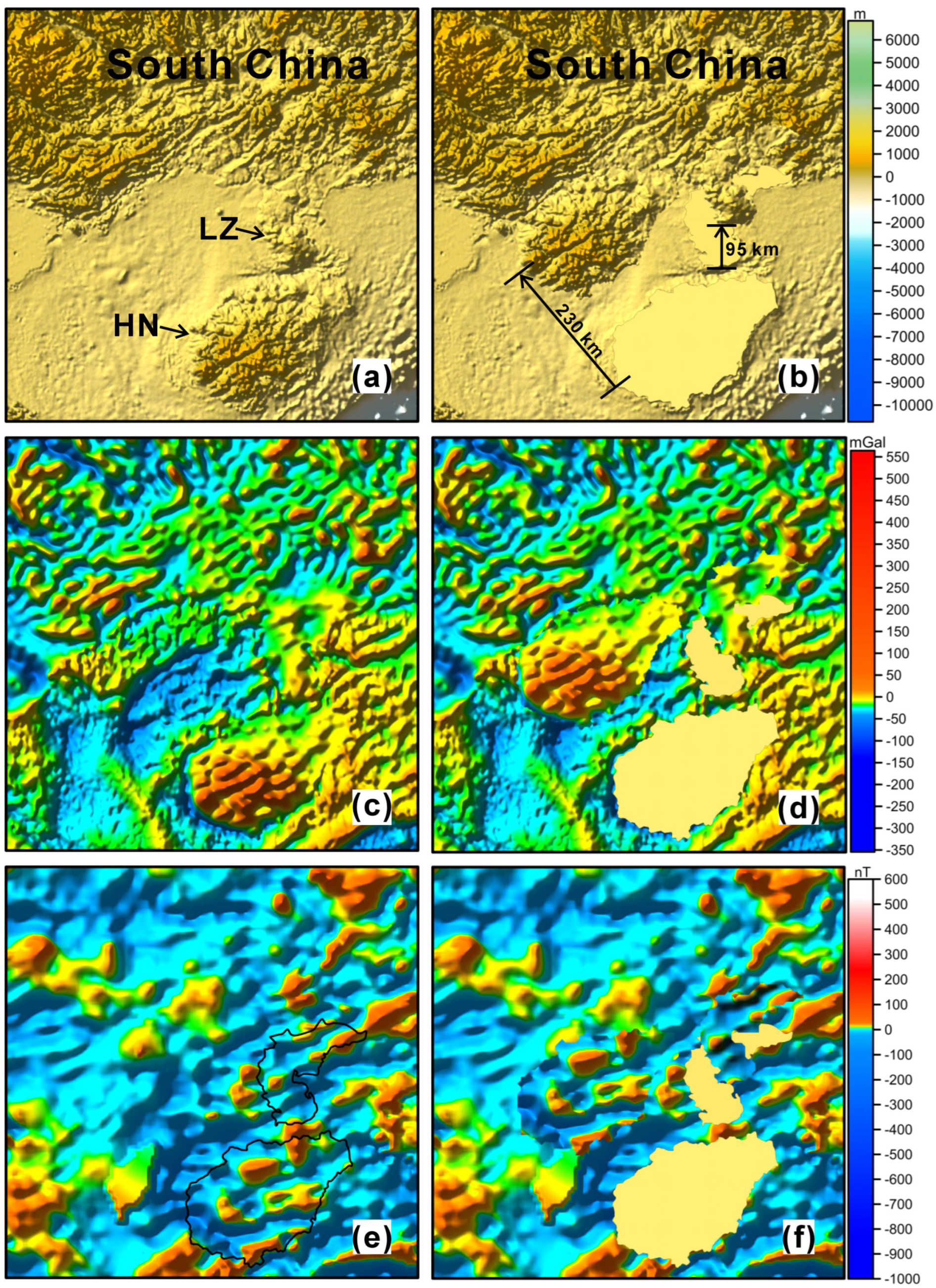

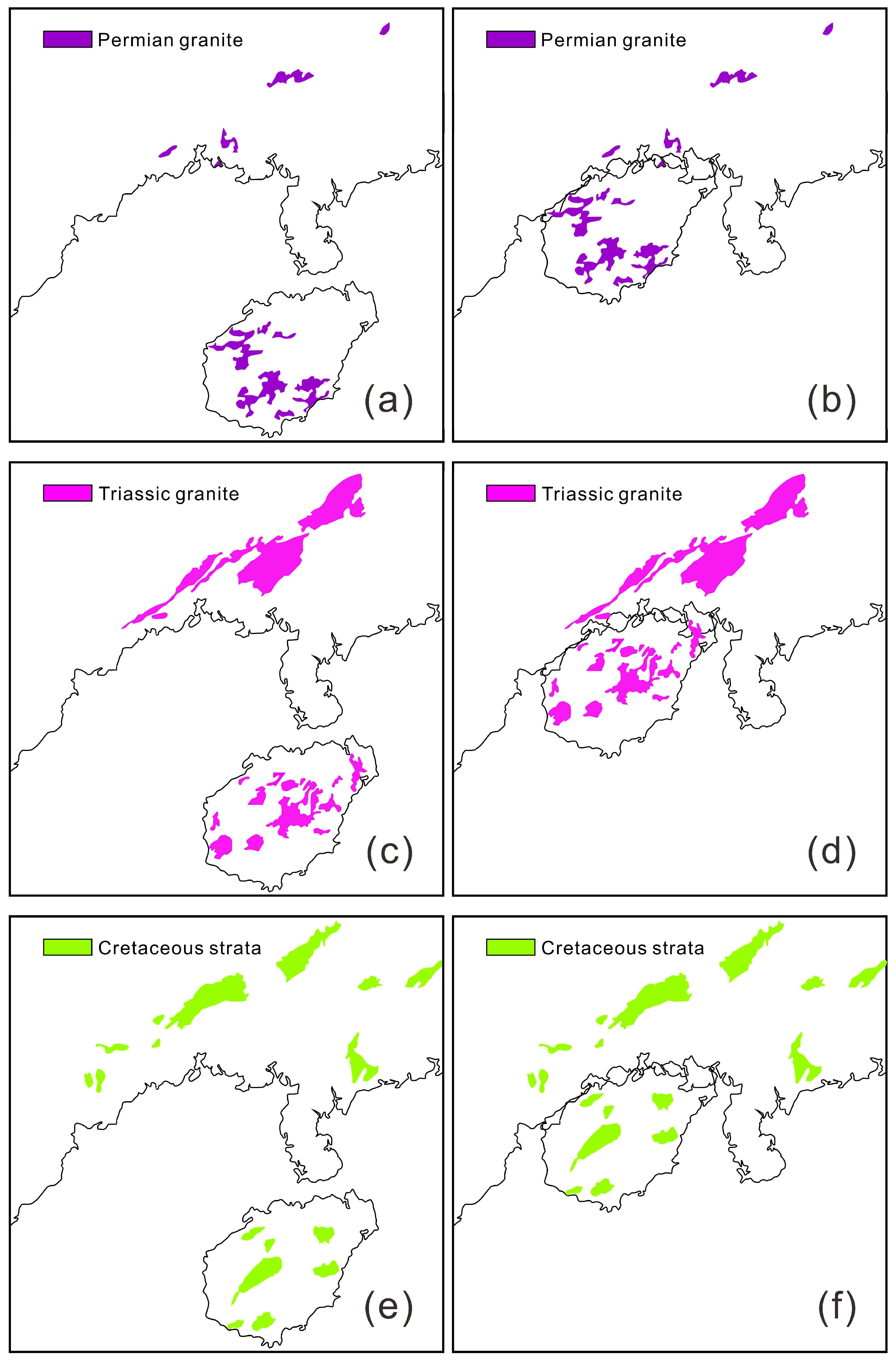
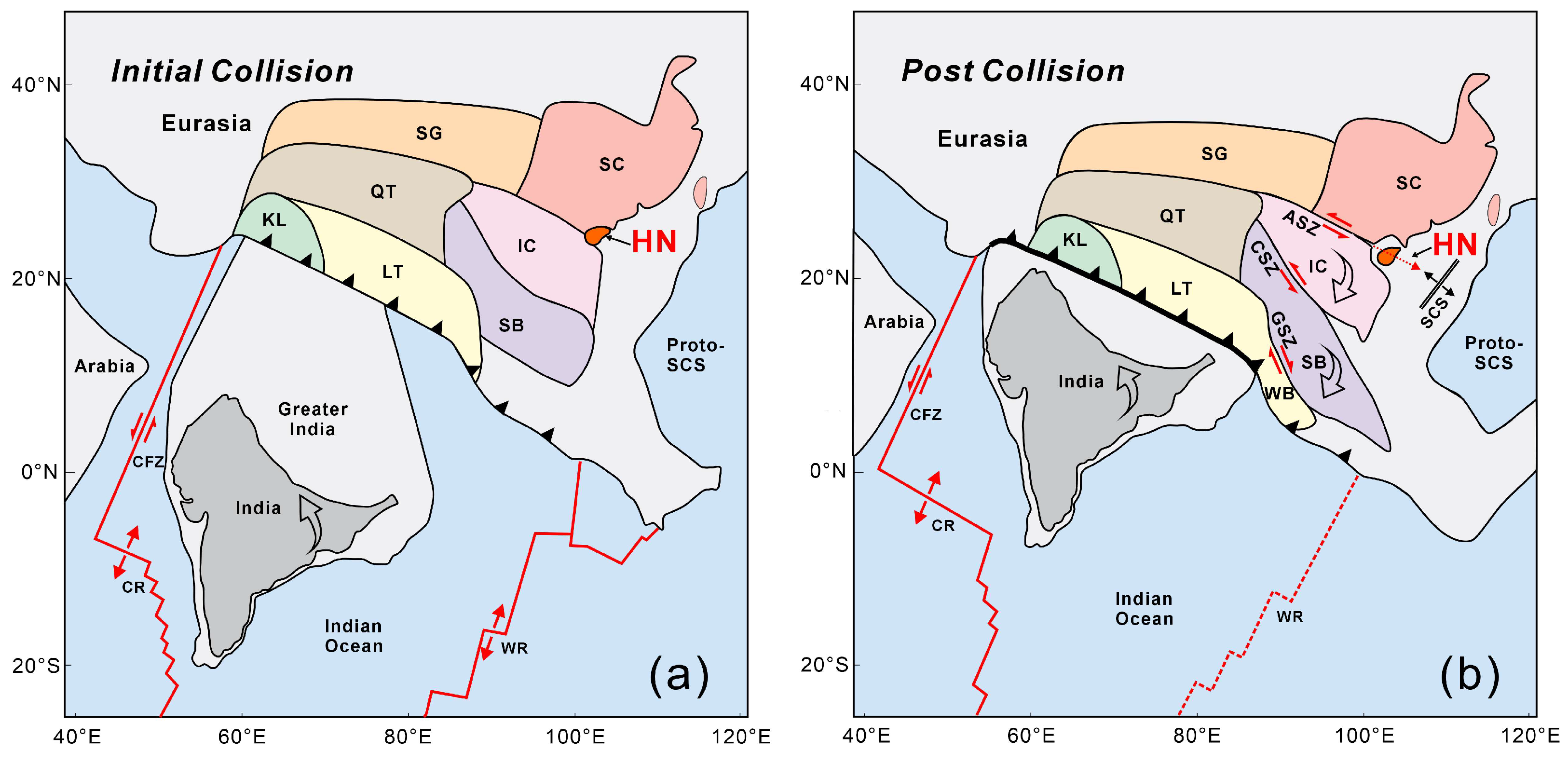
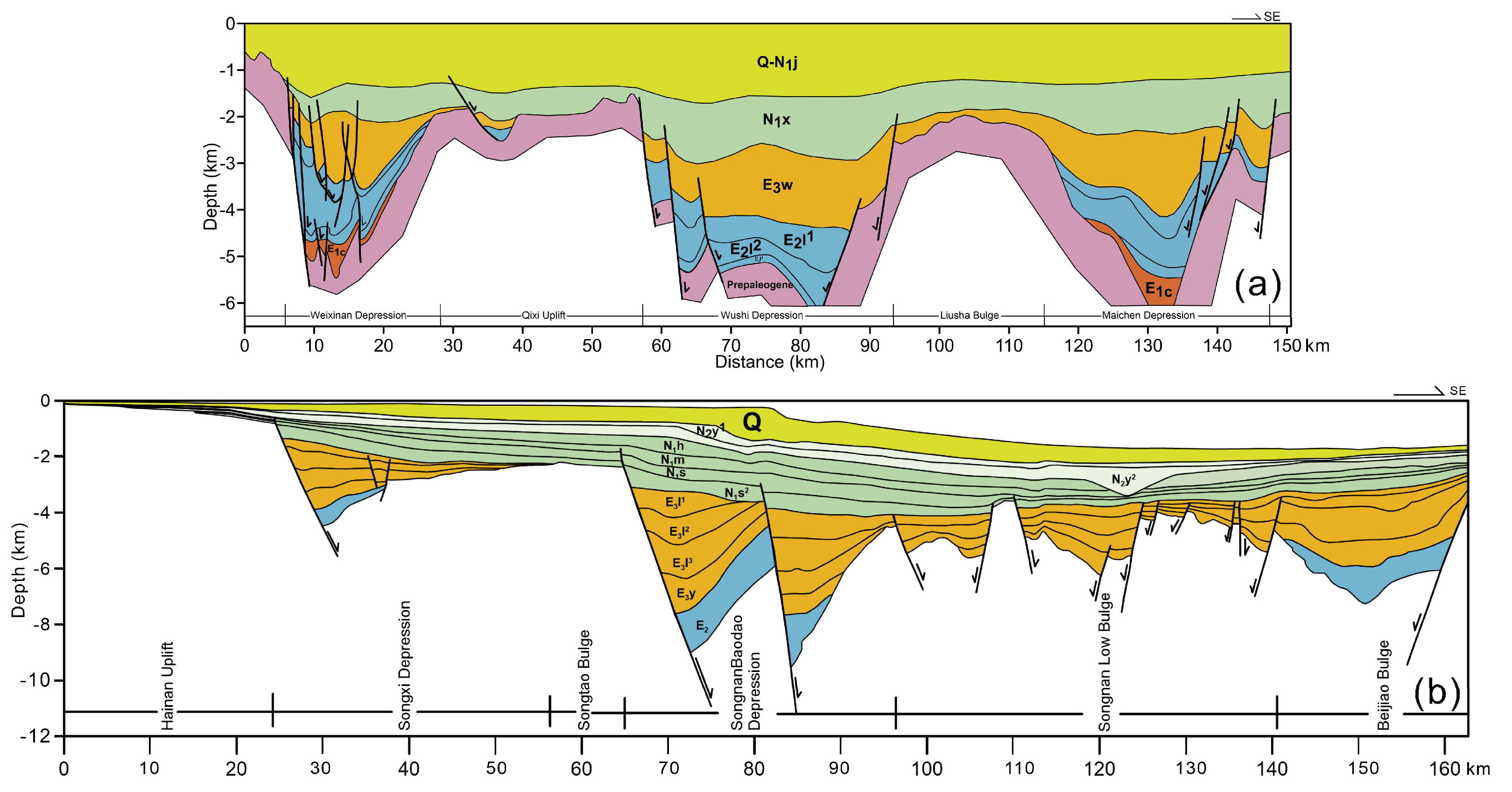
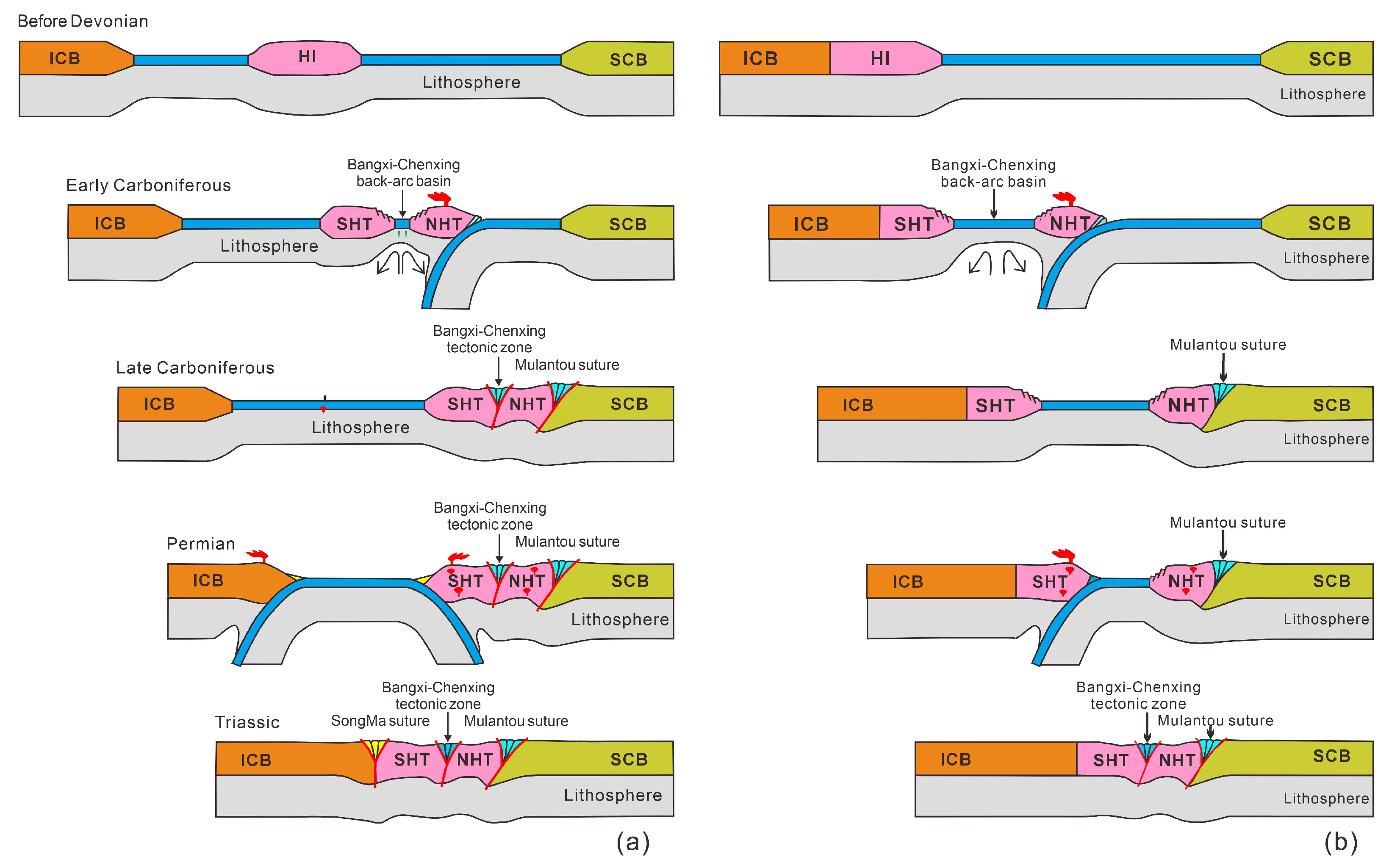
Disclaimer/Publisher’s Note: The statements, opinions and data contained in all publications are solely those of the individual author(s) and contributor(s) and not of MDPI and/or the editor(s). MDPI and/or the editor(s) disclaim responsibility for any injury to people or property resulting from any ideas, methods, instructions or products referred to in the content. |
© 2025 by the authors. Licensee MDPI, Basel, Switzerland. This article is an open access article distributed under the terms and conditions of the Creative Commons Attribution (CC BY) license (https://creativecommons.org/licenses/by/4.0/).
Share and Cite
Wang, M.; Zhou, Y.; Yao, Y.; Zhang, W.; Zhou, H.; Liu, Q. Reconstruction of the Cretaceous Palaeogeographic Position of Hainan Island and Its Tectonic Significance. J. Mar. Sci. Eng. 2025, 13, 1681. https://doi.org/10.3390/jmse13091681
Wang M, Zhou Y, Yao Y, Zhang W, Zhou H, Liu Q. Reconstruction of the Cretaceous Palaeogeographic Position of Hainan Island and Its Tectonic Significance. Journal of Marine Science and Engineering. 2025; 13(9):1681. https://doi.org/10.3390/jmse13091681
Chicago/Turabian StyleWang, Mingming, Yang Zhou, Yongjian Yao, Weijie Zhang, Huaiyang Zhou, and Qingsong Liu. 2025. "Reconstruction of the Cretaceous Palaeogeographic Position of Hainan Island and Its Tectonic Significance" Journal of Marine Science and Engineering 13, no. 9: 1681. https://doi.org/10.3390/jmse13091681
APA StyleWang, M., Zhou, Y., Yao, Y., Zhang, W., Zhou, H., & Liu, Q. (2025). Reconstruction of the Cretaceous Palaeogeographic Position of Hainan Island and Its Tectonic Significance. Journal of Marine Science and Engineering, 13(9), 1681. https://doi.org/10.3390/jmse13091681





